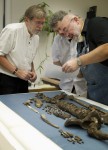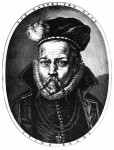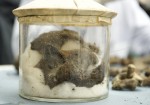 At least not by mercury. The suspicion first arose in 1996 when samples of his whiskers and hair which had been recovered during a 1901 exhumation of his remains were analyzed and found to contain elevated levels of mercury. Tycho Brahe’s body was exhumed again in 2010 so that the latest CAT scan, X-ray and neutron activation analysis could assess the levels of mercury in his hair and bones to determine if he really did die of mercury poisoning.
At least not by mercury. The suspicion first arose in 1996 when samples of his whiskers and hair which had been recovered during a 1901 exhumation of his remains were analyzed and found to contain elevated levels of mercury. Tycho Brahe’s body was exhumed again in 2010 so that the latest CAT scan, X-ray and neutron activation analysis could assess the levels of mercury in his hair and bones to determine if he really did die of mercury poisoning.
The cause of Brahe’s death had been subject to much gossip and urban-legending since he felt sick at a party in Prague and died 11 days later on October 24th, 1601. The official diagnosis was that he died of a bladder infection, but his assistant astronomer Johannes Kepler, who was witness to Brahe’s final days, wrote that his bladder had exploded because he refused to leave the dinner table to urinate because he didn’t want to be impolite. Rumors soon circulated that Kepler might have had reasons of his own to make up so outlandish a story, namely that he had poisoned Brahe to steal his ideas and pass them off as his own. Another poisoning rumor bandied about was that Tycho’s cousin Erik had poisoned him at the behest of King Christian IV of Denmark, who allegedly thought Brahe was sleeping with the King’s mother.
Determining whether mercury had a hand in his death wouldn’t resolve the question of whether he was deliberately killed. Mercury was used for all kinds of purposes back then. It was a terrifying treatment for syphilis and used in many other medical nostrums. Alchemists considered it the Prima Materia or “First Matter” from which all other metals sprang, so it was foundational in any attempt to transmute base metals into gold. Brahe could have been exposed to elevated levels of mercury in his work or in his daily life, just as we still are today.
 After two years of studying the samples taken during the 2010 exhumation, the team of researchers from Aarhus University in Denmark, the University of Southern Denmark and the Nuclear Physics Institute in Prague have sufficient information from his hair and bones to conclude that Tycho Brahe did not die of mercury poisoning, accidental or deliberate.
After two years of studying the samples taken during the 2010 exhumation, the team of researchers from Aarhus University in Denmark, the University of Southern Denmark and the Nuclear Physics Institute in Prague have sufficient information from his hair and bones to conclude that Tycho Brahe did not die of mercury poisoning, accidental or deliberate.
“We measured the concentration of mercury using three different quantitative chemical methods in our labs in Odense and Řež, and all tests revealed the same result: that mercury concentrations were not sufficiently high to have caused his death,” says Dr Rasmussen[, associate professor of chemistry at the University of Southern Denmark].
“In fact, chemical analyses of the bones indicate that Tycho Brahe was not exposed to an abnormally high mercury load in the last five to ten years of his life,” continues Dr Rasmussen, who analysed the bone samples using cold vapour atomic absorption spectroscopy at the University of Southern Denmark.
“Analyses of hairs from the beard were performed using radiochemical neutron activation analysis and proton microprobe scanning in Řež. They reflect the mercury load in the last approximately eight weeks of Tycho Brahe’s life, and these analyses show that mercury concentrations fell from the high end of the normal level eight weeks before death to the low end of the normal level in the last two weeks before death,” explains Dr Kučera[, professor of nuclear chemistry at the Nuclear Physics Institute in Prague].
So not only did he not have elevated levels of mercury in his system, he had lower levels of mercury in his system in his last weeks than previously. Considering his interest in medicine and alchemy, it’s rather remarkable that the levels of mercury found in his beard are no different than you’d find in any man’s beard today from general environmental exposure. Chemical analysis of his hair and bones turned up no evidence of any other kind of poison either.
 Another question the team has answered regards Tycho Brahe’s famous prosthetic nose. In 1566, when he was 20 years old and a student at the University of Rostock, Tycho had an argument about a mathematical formula with his third cousin and fellow student Manderup Parsberg. Since they could not resolve who was right by talking it out, they decided a duel with swords would pick the winner. At 7:00 PM on December 29th, Brahe and Parsberg fought in the dark. I guess Parsberg was right about that formula because the duel ended when he sliced off part of the bridge of Brahe’s nose. Tycho went home in April of 1567 and had a prosthetic device made to fill in the disfiguring hole in his nose. According to the legend that grew around the astronomer, his nose was made of silver or gold.
Another question the team has answered regards Tycho Brahe’s famous prosthetic nose. In 1566, when he was 20 years old and a student at the University of Rostock, Tycho had an argument about a mathematical formula with his third cousin and fellow student Manderup Parsberg. Since they could not resolve who was right by talking it out, they decided a duel with swords would pick the winner. At 7:00 PM on December 29th, Brahe and Parsberg fought in the dark. I guess Parsberg was right about that formula because the duel ended when he sliced off part of the bridge of Brahe’s nose. Tycho went home in April of 1567 and had a prosthetic device made to fill in the disfiguring hole in his nose. According to the legend that grew around the astronomer, his nose was made of silver or gold.
 When the body was exhumed in 1901, no metal nose was found buried with him. The exhumers did notice a greenish residue around the nasal cavity, however. They presciently placed the remains of the skull in a glass jar before reburial, which helped keep the residue and the mustache in good condition. Researchers this time around took bone samples from the nose to determine its chemical composition. They discovered that the green residue contained equal parts of copper and zinc, which means Tycho Brahe’s fake nose was made of brass, not of precious metals.
When the body was exhumed in 1901, no metal nose was found buried with him. The exhumers did notice a greenish residue around the nasal cavity, however. They presciently placed the remains of the skull in a glass jar before reburial, which helped keep the residue and the mustache in good condition. Researchers this time around took bone samples from the nose to determine its chemical composition. They discovered that the green residue contained equal parts of copper and zinc, which means Tycho Brahe’s fake nose was made of brass, not of precious metals.
The study is not yet complete. Analysis of Tycho’s teeth is ongoing, the results of which might provide an actual cause of death. Researchers also plan to do a facial reconstruction from the CT scans performed on his skeleton in 2010.
This whole process, from the early attempts to get permission to exhume the body to exhumation to laboratory analysis to publication, has been followed by a documentary film crew from the Danish Broadcasting Corporation. The documentary aired last night on Danish, Swedish and Czech television. There is no word yet on whether it will air in other markets, but apparently US and German television stations have expressed interest in picking it up. Fingers crossed!